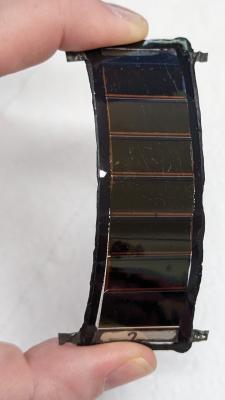Australian start-up Halocell will reportedly begin producing flexible 7 centimeter-long photovoltaic strips that are said to generate enough power to replace the pair of disposable batteries in a TV remote, or the charger cable for a set of headphones. This represents the first large-scale manufacturing in Australia of perovskite PV technology.
The 5-volt Halocell perovskite strip. Image credit: Halocell
The Halocell modules will each cost less than a dollar to make and the Company has ambitious plans to produce millions per year, its CEO Paul Moonie said.
Once considered a great hope of the Australian solar industry, Greatcell (formerly Dyesol) was among the world's leading perovskite developers, but could not compete with the low-cost silicon solar panels for full-sun applications despite a $6 million government grant. "When Greatcell collapsed myself and some investors bought its equipment and patents and set up operations in Wagga," former employee of the company, Mr. Moonie, now Halocell CEO, said.
Greatcell's collapse taught that Mr. Moonie not to compete with silicon outdoors, so Halocell focused on indoor applications. "We knew the indoor market was a much easier environment to operate in than full-sun outdoor."
Conventional silicon solar's narrow bandgap is good at converting the infrared photons in sunlight to electricity, but works terribly under the narrow spectra of indoor light. The cells operate at less than 5% efficiency in the white glow of indoor light, whereas perovskite cells can be tuned to generate electricity optimally in these conditions.
Halocell's perovskite cells operate at 27% efficiency in low indoor light (50 lux) and 22% in bright indoor light (1000 lux), according to the Company's product specifications.
The modules are less than a millimeter thick, can be printed for low-cost on long continuous rolls of plastic, operate from -10 to 60 degrees Celsius, and come with a five-year warranty for indoor use. Durability has been improved (to the standard for indoor use) with the addition of a protective coating.
According to Mr. Moonie, a single module produces enough power to replace the batteries in a TV remote or power a set of headphones, and had an acceptable lead content based on guidance from the US Environmental Protection Agency.
"We're starting out at 8,000 a year and will be constantly increasing that output," he said. "Eventually we want to be around 70 million units a year.
Hongxia Wang, a perovskites expert at the Queensland University of Technology who led a government-funded co-operative research project with Halocell, said it was the only Australian company manufacturing perovskite cells at scale. "I think the initiative of development of indoor power by Halocell is quite significant," Professor Wang said.
Professor Ho-Baillie's team at the University of Sydney is also working to commercialize perovskite solar cells with the start-up SunDrive, but they are yet to announce manufacturing plans.
Perovskites aren't the only emerging technology for indoor solar. Dye-sensitized solar cells (DSSC) contain a porous layer of titanium dioxide nanoparticles covered in a dye that absorbs incoming photons from the sun. The excited electrons in the dye flow through an external circuit, generating electricity. It's analogous to how plants use photosynthetic pigments like chlorophylls to broaden the range of light they can absorb. DSSCs are relatively inefficient in full sunlight, but perform better than conventional silicon cells in low light. They can be printed as a thin film on a range of materials, and are low-cost and relatively durable.
A number of start-ups as well as companies such as Google and Adidas are integrating the cells into a range of consumer products such as bags, bracelet-style health trackers, bike helmets, remote controls, sensors and "self-charging" headphones.
But for solar cell makers the real prize is success under the sun.
Mr. Moonie hopes that once perovskite has proved itself indoors, and solved some of its remaining durability issues, it will compete with low-cost silicon solar outdoors.
"I think we'll be pumping out rooftop solar by 2030," Mr. Moonie said.
Martin Green, the University of NSW professor credited with partly inventing the technology used in most of today's solar cells, said low-cost commercial perovskite-silicon tandem cells were the "holy grail" for many researchers. "If you can make the modules twice as efficient then you halve the cost of solar automatically."




